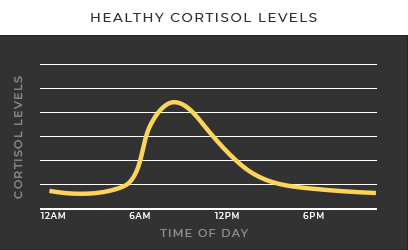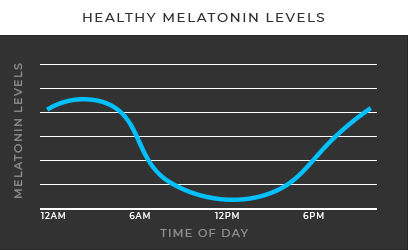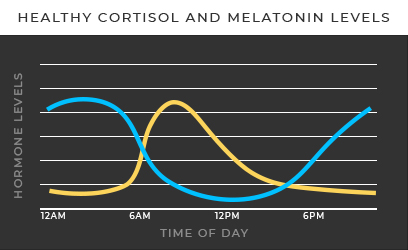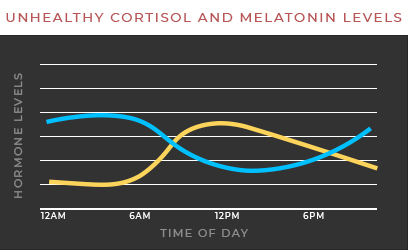Whether it’s a morning routine, bedtime routine, or meal prep routine, I think the routines we build play a significant role in our health and happiness. But I’ve recently discovered something that I now believe should be incorporated into everyone’s morning routine. Something that kickstarts our day into peak alertness, clarity, and energy. And something that will downregulate our body at nighttime for optimal sleep. And it’s not only free but accessible to everyone. Let me introduce you to… the morning walk.
Circadian Rhythm
Now I know you were probably expecting something cool like a superfood energy supplement or a Bikram yoga power flow but let me explain why the morning walk is all that and more. All of us have a circadian rhythm which is like a 24-hour internal clock. And based upon the time of day, our circadian rhythm will regulate our hormone production, body temperature, and other factors which influence our wakefulness and sleepiness. For example, our cortisol production, which impacts our wakefulness, spikes in the morning, and tapers off later into the day. And later into the day, our melatonin production spikes, which impacts our sleepiness, and tapers off throughout the night and into the morning. And this is all determined by our 24-hour circadian rhythm which is predominately set by light exposure.


But the interesting part is without light exposure to set our circadian rhythm, our rhythm will vary greatly and tend to shift beyond the 24-hour day. We know this because people have done experiments where they’ve lived in caves in complete darkness for months at a time. I wouldn’t recommend trying this as it had some nasty effects on the subjects but what they found was that the subjects started to go to sleep later, sleep longer, and function on a 24 hour and 30-minute clock on average. And what we can learn from this is that if we want to maintain a 24hr day, where we awake energized at the same time every morning, and we sleep deeply at the same time every night, we need daily light exposure to set our circadian rhythm’s clock.
Light Exposure
This is where early morning light exposure comes in. Ideally, we want to be outside for at least 5 minutes and optimally 30 minutes. And we want to do this between 6-8:30am when the sun is rising. This early morning light exposure will pump the breaks on our melatonin production and put the pedal to the metal on our cortisol production. In a healthy way! This sets us up to be wide awake, alert, and energetic to start our day. And it also sets our nightly timer to reduce cortisol production and increase melatonin production as we creep closer to bedtime. But, without this early morning light exposure, we see less significant and less coordinated releases of cortisol and melatonin which leads to more grogginess during the day, and less sleepiness at nighttime.


But not just any light will do the trick. It turns our sunlight is optimal for numerous reasons including:
All of these are reasons why ideally you want your light exposure outdoors, and in the early morning. And don’t forget to leave the sunglasses behind because we want that bright light to facilitate all these processes. Now, don’t look dead into the sun or do anything stupid. This shouldn’t be painful or dangerous.
Movement and Cognitive Effects
And now that we understand the importance of early morning outdoor light exposure, let’s couple that with some movement. Walking. If you ask the average person how they feel right now on a scale of 1-5, most people will say 2. Satisfied. If you ask them how they think they’ll feel after a 30-minute walk, they’ll say 2 again. Still satisfied. But if you force these people to perform a 30-minute walk and ask them again how they actually feel, most of them will say 4/5. Great. And this has been proven in many scientific studies even in individuals who dread walking. This is because walking increases our heart rate and blood flow which aids in delivery of nutrients, oxygen, and happiness hormones like dopamine throughout the brain and body.
And what are the effects of this? First, our mood is boosted and we’re happier than before. Second, we’re more creative. Just 5-10 minutes of walking has been shown to increase idea creation by 2x! Third, we’ll feel more energized. Walking stimulates the hormonal release of cortisol, epinephrine, and norepinephrine which makes us feel awake and alive. Fourth, increased immune health. One study showed that people who walked 30-45 minutes per day had 43% less sick days than those who didn’t walk daily. And fifth, disease prevention. Walking is also associated with decreased risk for cardiovascular disease, diabetes, and all-cause mortality. And as Professor Shane O’Mara said, you don’t stop walking when you get old. You get old when you stop walking.
Pro Tip: Walk Backwards
And a quick pro tip. If you want optimal results and you’re willing to disregard everyone else’s judgements around you, spend 25% of your morning walk going backwards. Studies have shown numerous benefits to this including knee injury prevention, increases in balance, reduction in falls, and improvements in overall movement quality. Some studies have actually compared groups of people training for a sprinting and vertical leap event. What they found was the group that trained with backwards sprinting exercises performed better in the forward sprint and vertical leap compared to the group that trained forwards with sprinting exercises. Wild. This is something I’ve been doing lately and it’s an interesting experience. I think its gotta have cognitive benefits too as its mentally challenging.
Final Thoughts
If you’re looking for a terrific way to start your day that will lead to alertness, wakefulness, creativity, and a mood boost… walking outdoors early in the morning is your answer. If you’re looking to end your day in a state of sleepiness and calmness that transitions into a high-quality deep sleep… walking outdoors early in the morning is your answer. The early morning sun exposure coupled with movement from walking is a routine you definitely have to try adding to your day. And if you’re getting ambitious, try doing 25% of it backwards. I think this super simple routine can provide incredible benefits. So, get walking to a healthier and happier life tomorrow morning.
Looking for the top three things I’ve read, watched, and listened to this week? Check out my free health kit and weekly newsletter.
Watch a YouTube Video Summarizing the Post

Hey, I am Brandon Zerbe
Welcome to myHealthSciences! My goal has always been to increase quality-of-life with healthy habits that are sustainable, efficient, and effective. I do this by covering topics like Fitness, Nutrition, Sleep, Cognition, Finance and Minimalism. You can read more about me here.
Sources:
- Why Walking Is The Superpower You Didn’t Know You Had with Professor Shane O’Mara
- Why We Sleep: Unlocking the Power of Sleep and Dreams
- Sleep Smarter: 21 Essential Strategies to Sleep Your Way to A Better Body, Better Health, and Bigger Success
- Master Your Sleep & Be More Alert When Awake | Huberman Lab Podcast #2
- Therapeutic Efficacy Of Walking Backward And Forward On A Slope In Normal Adults
- This Explorer Discovered Human Time Warp By Living In A Cave
- Seeing the Light — How Blue Light Can Benefit Us
- What Are Circadian Rhythms?
- What Are the Benefits of Walking?
